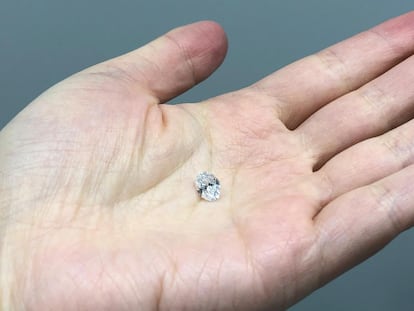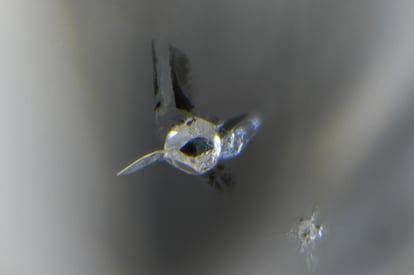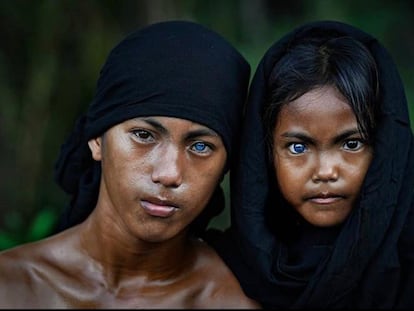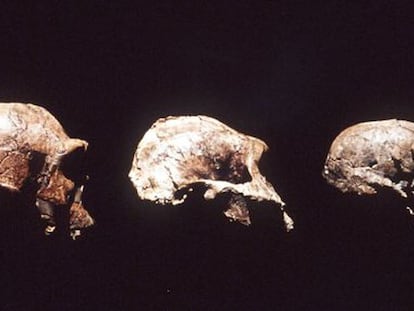Rare diamond destined for a jewelry store has precious geological value
The gem from 410 miles down in Earth’s mantle reveals clues about oceans of water hidden deep within our planet

Gemologist Tingting Gu was working at the Gemological Institute of America (GIA) in New York when a diamond came to her for analysis and appraisal. It was to be set in a ring and sold in a jewelry store before she realized the geological significance of the gem under her microscope. It was the second ringwoodite diamond ever discovered.
To validate her find, Gu contacted Fabrizio Nestola, a professor with the Department of Geosciences at Italy’s University of Padua. The IaB-type diamond is very rare because it shows a mineral accumulation of ringwoodite with ferropericlase and enstatite. “This is the first time that this combination has occurred, which validates our laboratory experiments and provides us with exceptional new knowledge about the composition and structure of one of Earth’s most inaccessible and remote places,” said Nestola, co-author of the study published in Nature.
The 1.5 cm diamond comes from the Karowe mine in Botswana in southern Africa. A chemical analysis of the gem indicates that it originated 410 miles (660 kilometers) below the Earth’s mantle, where it came in contact with water. This finding changes scientists’ current understanding of the Earth’s subsoil in that water is now believed to be much more prevalent at that depth than previously thought.

Diamonds are geological time machines. High pressure and temperatures formed diamonds in Earth’s depths millions of years ago. Volcanic eruptions, earthquakes and tectonic plate movements then brought them up to the Earth’s crust. Diamonds are one of the best sources of information about what is happening deep inside the Earth, an environment to which scientists have no direct access.
The diamond that came into Tingting Gu’s hands contains ringwoodite, which is a magnesium silicate mineral first discovered in 1969 in a meteorite that struck Australia. The first terrestrial ringwoodite sample was excavated in 2014 from the Juína mine in Brazil, sealed inside a “super-deep” diamond, according to Nestola. The discovery confirmed scientific theories about the Earth’s mantle, which can only be studied via the deposits expelled by geological cataclysms. It most likely emerged millions of years ago from the depths through a “chimney” of kimberlite volcanic rock. “This was very helpful,” says Nestola, “because the longest manmade shaft ever built only goes 7.5 miles deep.”
Ringwoodite is nothing more than an olivine, one of the most common minerals in the Earth’s upper mantle, just below the crust, “… to which great atmospheric pressure has been applied,” says geologist Javier García Guinea, of Spain’s National Museum of Natural Sciences. García Guinea, who was not involved in the rare discovery, says the study is “continuist” in nature, but acknowledges that “this is science, which is done step-by-step.”
The analysis of the IaB-type diamond indicates that it comes from a transition zone between the second and third layers of the Earth, at a depth of between 250 and 420 miles. The diamond was formed at a pressure of 23.5 GPa (gigapascals), and a temperature of about 3,000ºF (1,650ºC). To help us comprehend these facts, Nestola explains: “The pressure that crushes the atoms of the mineral into a diamond is immense – a single gigapascal is equivalent to four Mount Everests on top of your head.”
The presence of H₂O in the Earth’s lower mantle has implications for the structure and evolution of the planetGeologist Antonio García Casco (Department of Mineralogy and Petrology, University of Granada, Spain).
The chemical composition of the IaB-type diamond suggests that there are oceans of water between the Earth’s substrata, “which is not new information – this has been known for decades,” says geologist Antonio García Casco, from the Department of Mineralogy and Petrology at Spain’s University of Granada. But at those extreme depths, water is not the liquid we see on the surface. “It [H₂O] is transformed into a fluid that’s half-liquid and half-gas. It adheres to minerals and can comprise between 10-20% of their weight,” says García Casco.
García Casco says the study about the IaB-type diamond is significant because it leads us to “infer the presence of free-flowing H₂O in the lower mantle,” which has implications for “the structure and evolution of the planet. For example, implications for mantle convection and plate tectonics, which permanently change the planet.” For García Casco, this study is an opportunity for mineralogists to observe transformation processes that only occur “at depths that will be forever inaccessible.”
The diamond, saved in the nick of time from ending up in an engagement ring, “freezes and captures its environment, and then ferries it up from the depths until it reaches the light of day,” says Nestola. For geologists like him, the more material a gem absorbs, the more valuable it is to science. “Just the opposite for a jeweler,” he laughs.
Tu suscripción se está usando en otro dispositivo
¿Quieres añadir otro usuario a tu suscripción?
Si continúas leyendo en este dispositivo, no se podrá leer en el otro.
FlechaTu suscripción se está usando en otro dispositivo y solo puedes acceder a EL PAÍS desde un dispositivo a la vez.
Si quieres compartir tu cuenta, cambia tu suscripción a la modalidad Premium, así podrás añadir otro usuario. Cada uno accederá con su propia cuenta de email, lo que os permitirá personalizar vuestra experiencia en EL PAÍS.
¿Tienes una suscripción de empresa? Accede aquí para contratar más cuentas.
En el caso de no saber quién está usando tu cuenta, te recomendamos cambiar tu contraseña aquí.
Si decides continuar compartiendo tu cuenta, este mensaje se mostrará en tu dispositivo y en el de la otra persona que está usando tu cuenta de forma indefinida, afectando a tu experiencia de lectura. Puedes consultar aquí los términos y condiciones de la suscripción digital.
More information
Últimas noticias
Reinhard Genzel, Nobel laureate in physics: ‘One-minute videos will never give you the truth’
Pinochet’s victims grapple with José Antonio Kast’s rise in Chile
Half of Scotland is in the hands of 420 property owners
From digital curfews to blocking apps: How technology experts protect their children online
Most viewed
- Pablo Escobar’s hippos: A serious environmental problem, 40 years on
- Reinhard Genzel, Nobel laureate in physics: ‘One-minute videos will never give you the truth’
- Why we lost the habit of sleeping in two segments and how that changed our sense of time
- Charles Dubouloz, mountaineering star, retires at 36 with a farewell tour inspired by Walter Bonatti
- The Florida Keys tourist paradise is besieged by immigration agents: ‘We’ve never seen anything like this’










































